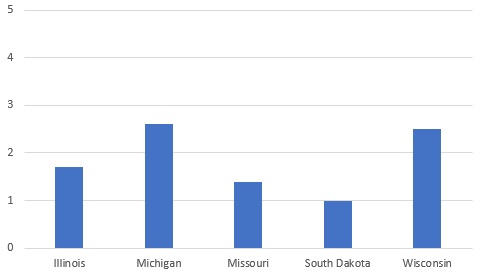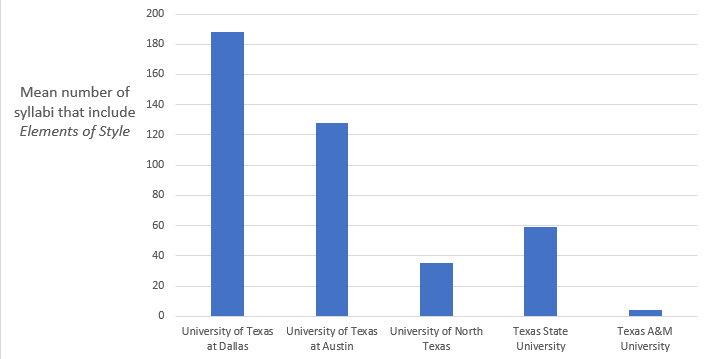Chapter 9. The Open Syllabus Project: Everything Up to the Single-Sample t Test
Introduction
By Marsha J. McCartney, The University of Kansas, and Susan A. Nolan, Seton Hall University
Ha, Thu-Huong. (2016). These are the books students at the top US colleges are required to read. Quartz. Opens in new window https://qz.com/602956/these-are-the-books-students-at-the-top-us-colleges-are-required-to-read/
Syllabus Explorer. (n.d.). Retrieved December 28, 2016, from Opens in new window https://opensyllabusproject.org/.
Introduction

In this activity, we’ll look at some data from the Open Syllabus Project, which has collected more than a million syllabi from the Web sites of universities in Australia, Canada, New Zealand, the United Kingdom, and the United States. Data from these syllabi are available through the Syllabus Explorer, creating a truly awesome dataset that we’ll explore in this activity. Check out the website at https://opensyllabusproject.org/ for more information. Have you ever thought about the hours that your instructors spend constructing just one syllabus for a single class? The syllabus is the roadmap for the course, and is perhaps the most important document for student success. As a student, you may browse through the syllabus quickly, transfer all the important dates to your planner, and file it away. This activity might make you think more attentively about the content of your syllabi. The Open Syllabus Project has a lot of data that can be analyzed based on these syllabi! Of the over 1.1 million syllabi that have been added so far, 933,635 readings have been assigned. Just in the United States, there are 100,000 readings. We can sort these readings in various ways, including by academic discipline and state.
Example 1 of 3
Let’s take a closer look at the percentage of U.S. readings that relate to the discipline of psychology. Across all states, the mean percentage of readings that are psychology–related is 12.8%. We’ll consider this the population mean. Imagine that you want to know how the Midwest fares in its psychology offerings compared with the rest of the country. You decide to look at a sample of states within the Midwest (Illinois, Michigan, Missouri, South Dakota, and Wisconsin) to determine if the mean percentage for psychology readings used in that region is significantly different than in all of the United States. The percentages for the states in the sample are: Illinois (1.7%), Michigan (2.6%), Missouri (1.4%), South Dakota (1.0%), and Wisconsin (2.5%).

The average percentage for psychology readings within the Midwest, Image Long Description
The average percentage for psychology readings within the Midwest. The left column represents the state. The right column is the corresponding percentage.
| Illinois | 1.7% |
| Michigan | 2.6% |
| Missouri | 1.4% |
| South Dakota | 1.0% |
| Wisconsin | 2.5% |

Choosing the Appropriate Hypothesis Test, Image Long Description
By asking the right questions about our variables and research design, we can choose the appropriate hypothesis test for our research.
Four Categories of Hypothesis Tests (IV = Independent variable; DV = dependent variable)
Example 1 of 3
What statistical analysis could be used to determine if the mean percentage of psychology readings assigned in the Midwest was significantly different than in all of the United States?
Now skip ahead to the next example by clicking here. Or, for more practice walking through the flowchart questions, simply click the Next button in the bottom right corner of the screen.
Example 1 of 3
In which of the following four categories does this situation fall? Click to see the data again. And click on the flowchart button to see the overview for choosing the best test.

Data from: https://opensyllabusproject.org/ (2017)
Example 1 of 3
How many nominal independent variables are there?
Example 1 of 3
How many levels does this independent variable have?
Example 1 of 3
How many samples are there?
Example 1 of 3
For the level represented by a population, what parameters do you know with respect to the scale dependent variable?
Example 1 of 3
Based on the answers to these questions, what test would you use?
Example 2 of 3
Reporter Thu-Huong Ha (2016) used the Open Syllabus database to determine which readings were most frequently assigned at a sample of ten top U.S. universities. She found that these lists were dominated by humanities readings such as Plato’s Republic and Thomas Hobbes’s Leviathan. With some extra work, Ha could compare her sample of top schools to U.S. universities of all levels. For each university, she would calculate the proportion of the most frequently assigned readings that are from humanities disciplines. She would then calculate a mean and standard deviation for all U.S. universities in the database. For the purposes of this example, we’ll treat the entire Open Syllabus database as the population.
If we wanted to compare the proportion of frequently assigned readings that are in the humanities at the sample of top universities to the proportion in the population of all universities, what analysis could we use?
Now skip ahead to the next example by clicking here. Or, for more practice walking through the flowchart questions, simply click the Next button in the bottom right corner of the screen.
Example 2 of 3
In which of the following four categories does this situation fall? Click to see the data again. And click on the flowchart button to see the overview for choosing the best test.
Reporter Thu-Huong Ha used the Open Syllabus database to determine which readings were most frequently assigned at a sample of ten top U.S. universities (2016). She found that these lists were dominated by humanities readings such as Plato’s Republic and Thomas Hobbes’s Leviathan. With some extra work, Ha could compare her sample of top schools to U.S. universities of all levels. For each university, she would calculate the proportion of the most frequently assigned readings that are from humanities disciplines. She would then calculate a mean and standard deviation for all U.S. universities in the database. For the purposes of this example, we’ll treat the entire Open Syllabus database as the population.
Example 2 of 3
How many nominal independent variables are there?
Example 2 of 3
How many levels does this independent variable have?
Example 2 of 3
How many samples are there?
Example 2 of 3
For the level represented by a population, what parameters do you know with respect to the scale dependent variable?
Example 2 of 3
Based on the answers to these questions, what test would you use?
Example 3 of 3
For the next example, let’s say you are an English instructor at a college in Texas. You are interested in finding out how the use of William Strunk’s The Elements of Style at universities in Texas compares to the use of this text at universities across the entire United States. This book is the most used textbook in the database. It is listed on 3,934 syllabi. The mean number of times that this book is listed on syllabi across all 210 universities in the population is 18.73. We can calculate the mean and standard deviation for the number of syllabi that list this book at a randomly selected sample of five Texas universities: the University of Texas at Dallas, University of Texas at Austin, University of North Texas, Texas State University, and Texas A&M University. The mean for this sample of Texas universities is 82.8, with a standard deviation of 74.45.

William Strunk’s The Elements of Style in Universities of Texas, Image Long Description
The mean and standard deviation for the number of syllabi that list this book at a randomly selected sample of five Texas universities. The left column is the university, and the right column is the corresponding value.
| University of Texas at Dallas | 188 |
| University of Texas at Austin | 128 |
| University of North Texas | 35 |
| Texas State University | 59 |
| Texas A&M University | 4 |
Example 3 of 3
What analysis could be used to find out if universities in Texas use Elements of Style a significantly different number of times than do all universities in the United States?
Now skip ahead to the end of the activity by clicking here. Or, for more practice walking through the flowchart questions, simply click the Next button in the bottom right corner of the screen.
Example 3 of 3
In which of the following four categories does this situation fall? Click to see the data again. And click on the flowchart button to see the overview for choosing the best test.
 Data from: https://opensyllabusproject.org/ (2016)
Data from: https://opensyllabusproject.org/ (2016)
Example 3 of 3
How many nominal independent variables are there?
Example 3 of 3
How many levels does this independent variable have?
Example 3 of 3
How many samples are there?
Example 3 of 3
For the level represented by a population, what parameters are known with respect to the scale dependent variable?
Example 3 of 3
Based on the answers to these questions, what test could be used?
9.1 Activity Completed!

Congratulations! You have completed the activity and gained some good experience in choosing the best hypothesis test.